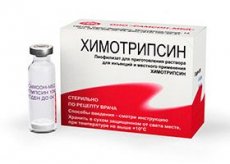Medical expert of the article
New publications
Preparations
Chymotrypsin
Last reviewed: 03.07.2025

All iLive content is medically reviewed or fact checked to ensure as much factual accuracy as possible.
We have strict sourcing guidelines and only link to reputable media sites, academic research institutions and, whenever possible, medically peer reviewed studies. Note that the numbers in parentheses ([1], [2], etc.) are clickable links to these studies.
If you feel that any of our content is inaccurate, out-of-date, or otherwise questionable, please select it and press Ctrl + Enter.

Indications Chymotrypsin
It is used in such cases:
- in case of fresh thrombosis in the area of the central vein of the retina (extensive type) and clouding of the vitreous body due to inflammation or damage;
- in anterior uveitis, iritis, hemorrhages in the anterior part of the eye chamber, swelling of the tissues around the eyes due to injuries or after surgery, as well as in the extraction of intracapsular cataracts;
- in bronchitis or tracheitis, pulmonary inflammation or abscess and bronchial asthma accompanied by hypersecretion;
- to prevent complications from occurring as a result of operations in the lung area;
- for bedsores, various purulent wounds, as well as burns or thrombophlebitis;
- for otitis, purulent sinusitis, osteomyelitis, tubootitis with viscous effusion.
Pharmacodynamics
A proteolytic enzyme medicine that is extracted from the pancreas of cattle. It helps break down the bonds that exist between peptides within protein molecules, as well as the bonds that are formed with the participation of the remaining particles of aromatic amino acids - thus it has an anti-inflammatory effect.
Lyses dead tissue without affecting areas with living cells. This is achieved due to the presence of specific antienzymes in the drug.
Dosing and administration
Chymotrypsin solution injections should be administered intramuscularly, in the amount of 5-10 mg per day (for children, the dosage is 2.5 mg once per day). Before use, it is necessary to dissolve 10 mg of the drug in a solution of sodium chloride or novocaine (0.5-2%; take 2 ml of such a solution), and then inject deeply into the buttock area (outer upper quadrant). About 6-15 injections are made per course.
In ophthalmology it is used for intramuscular injections, for a special solution in baths (0.2%) or in a solution (0.25%) for eye drops (3-4 times a day for a period of 1-3 days).
In pulmonology, the solution is administered intramuscularly - 5-10 mg per day, over a period of 10-12 days. To perform inhalations, 10 mg of the substance should be dissolved in a sodium chloride solution (3 ml), then used using an inhaler, or administered through an endotracheal tube or bronchoesophagoscope. The number of procedures depends on how effective the treatment is, as well as on the course of the pathology. It is necessary to rinse the nose or rinse the mouth with warm water after inhalation. The patient should cough up the accumulated sputum immediately after the procedure (or it should be sucked out if coughing is not possible).
In surgical procedures, the solution is administered:
- intramuscularly (for otitis, thrombophlebitis, purulent sinusitis, osteomyelitis, etc.);
- intrapleurally (with empyema or hemothorax);
- under the scab, using a syringe with a thin needle (for bedsores or burns);
- locally - using tampons previously soaked in the solution (elimination of purulent wounds).
The dose sizes and frequency of procedures depend on the medicinal indications.
 [ 16 ], [ 17 ], [ 18 ], [ 19 ], [ 20 ], [ 21 ], [ 22 ], [ 23 ]
[ 16 ], [ 17 ], [ 18 ], [ 19 ], [ 20 ], [ 21 ], [ 22 ], [ 23 ]
Use Chymotrypsin during pregnancy
There is no information on the use of Chymotrypsin in nursing mothers and pregnant women.
Contraindications
Among the contraindications:
- decompensated cardiac activity;
- pulmonary emphysema against the background of respiratory failure;
- liver cirrhosis, and also dystrophy;
- infectious form of hepatitis, pancreatitis, and hemorrhagic diathesis.
It is prohibited to inject the solution into cavities where there was bleeding, and in addition, to apply it to ulcers formed on the surface of existing malignant tumors.
Caution is necessary when using it for respiratory diseases in people with active tuberculosis (in this case, the drug must be combined with specific drugs).
Side effects Chymotrypsin
After using the solution, side effects may appear in the form of hyperemia and pain at the injection site, as well as manifestations of allergies, tachycardia and a transient increase in temperature.
Occasionally, swelling or irritation of the conjunctiva may occur; hoarseness may develop after inhalation.
Interactions with other drugs
Chymotrypsin can be combined with bronchodilators and antibiotics.
If the medicine is used to prevent or eliminate allergy symptoms, it can be combined with antihistamines.
 [ 24 ]
[ 24 ]
Storage conditions
Chymotrypsin should be stored in a place protected from sunlight. Temperature limits are 0-10°C.
 [ 25 ]
[ 25 ]
Shelf life
Chymotrypsin can be used for no more than 3 years from the date of manufacture of the drug.
 [ 26 ]
[ 26 ]
Attention!
To simplify the perception of information, this instruction for use of the drug "Chymotrypsin" translated and presented in a special form on the basis of the official instructions for medical use of the drug. Before use read the annotation that came directly to medicines.
Description provided for informational purposes and is not a guide to self-healing. The need for this drug, the purpose of the treatment regimen, methods and dose of the drug is determined solely by the attending physician. Self-medication is dangerous for your health.

